Airlines on the (Business Class) Hot Seat Over Emissions


As other sectors of the global economy decarbonize, airlines are beginning to stick out like a sore thumb. Air travel is projected to account for 10 percent — or more — of greenhouse gas emissions, up from just 2 percent a few years ago. Industry leaders have been grappling with the problem for years and now it seems that a simple solution is at hand: ban business class.
Why airlines should ban business class
The latest development occurred last week, when Jozsef Varadi, CEO of Hungary’s Wizz Air, called on the global airline industry to ban business class. The ban would apply to trips of less than five hours.
On the surface, the idea makes sense.
Carbon calculators routinely score business class emissions much higher than economy, mainly because the seats take up more space. Seats that fold down into beds are not particularly necessary on relatively short flights, which explains the focus on flights of less than five hours.
Banning business class: it’s complicated
The picture becomes more complicated when you dig into the details, however.
One problem is that eliminating business class can add more weight to an airplane, since additional people and seats would be packed into a previously underused space.
The added weight will have an impact on fuel consumption, especially during takeoffs and landings, where more fuel is used compared to cruising.
Takeoffs and landings use proportionately more fuel on shorter flights, which further dilutes the impact of banning business class on trips of less than five hours.
In a perfect world, the additional seats per plane would mean that airlines could reduce the number of flights they offer.
However, that outcome is unlikely given the rising demand for air travel.
Why businesses should ban business class
Although online carbon calculators may oversimplify the difference between business and economy carbon emissions, evidence is mounting that there is a significant difference.
Aside from fuel consumption, other business class perks involve lifecycle carbon emissions related to oversized seats, extra food and drink, special airport lounges, and other amenities.
Regardless of what airlines do to reduce these emissions, businesses can improve their own carbon footprints by switching from business class to economy.
Better yet, businesses can take steps to eliminate unnecessary air travel.
In addition to carbon emissions, air travel involves high-altitude emissions of nitrogen oxides and other greenhouse gases that linger in the upper atmosphere for longer periods of time. Switching to surface travel makes a significant difference, economy or not.
Railways are the go-to alternative for surface travel, but for some journeys even a private car can involve lower carbon emissions than air travel, whether or not it’s an electric vehicle.
Airlines on the hot seat
As for the airlines themselves, in 2016 the global aviation industry embarked on an ambitious plan aimed at carbon neutral growth after 2020.
However, the plan is on track to fall short of its goals, partly due to an over-reliance on carbon offsets.
Offsets are needed as a short-term solution while technology improvements get under way, but Popular Mechanics took a deep dive into the topic of back in 2016, and it seems that airlines have some more ‘splaining to do.
One main problem is jet engine technology itself. Jet engines largely replaced piston-powered engines more than 50 years ago, as airlines took advantage of their improved speed and power.
The trade off, unfortunately, was fuel efficiency. According to Popular Mechanics, today’s jet engines are just about as efficient as the piston engines they replaced all those years ago.
There is still some wiggle room for improvement. Aircraft redesign is also making a difference, as is the introduction of biofuels and other alternatives, including hydrogen.
The problem is that these opportunities involve a long R&D timeline, or in the case of biofuels, tradeoffs with other impacts, before they emerge into mainstream air travel.
Carbon emissions in perspective
With climate action becoming more urgent by the day, businesses can step in. Aside from reducing their own air travel, they can help raise public awareness of the role that air travel plays in an individual’s carbon footprint.
That includes economy as well as business class. Last August the BBC ran the numbers and calculated that one person flying economy from London to New York incurs the same carbon emissions as they would by living in Ghana for an entire year.
To put it another way, carbon emissions from that one flight would account for a full 11% of the yearly emissions incurred by a person living in London.
Raising awareness won’t necessarily reduce global air travel by a significant measure. However, it may help motivate businesses — and individuals — to take a fresh look at their carbon footprint and seek additional ways to offset their air travel through improvements on the ground.
The technology for making a significant difference exists right here and now.
That includes replacing older ground fleets with new electric vehicles, acquiring more renewable energy, and upgrading older buildings with new energy efficient equipment.
Here in the U.S., businesses can also work more proactively with grassroots organizations to lobby state and federal legislators to support for clean tech improvements that help reduce the use of fossil fuels across the board.
Image credit: Tim Dennert/Unsplash
Volkswagen Makes Good on Electric Vehicle Promise


What a difference a year — or four — makes. In the fall of 2015, Volkswagen suffered an enormous blow to its reputation when the U.S. Environmental Protection Agency accused the automaker of cheating on emission tests for its diesel cars. Fast forward to 2019, and the company has chosen the U.S. as one of its standard bearers for the global electric vehicle revolution.
Volkswagen and the electric vehicle revolution
Volkswagen’s new U.S. venture is part of a broader pivot to zero emission technology, under which Volkswagen anticipates selling 1 million electric vehicles globally by 2025.
Volkswagen set the wheels in motion last January, when it announced that Chattanooga, Tennessee would host one of the first two facilities globally to produce electric vehicles at scale using the company’s new modular “electric toolkit” chassis. The other facility is located in Germany and several more will go online within the next few years.
It seems that all has gone according to plan. Last week Volkswagen broke ground on the new $800 million U.S. facility on the grounds of its existing plant in Chattanooga. The plant will continue to turn out conventional cars and will add production of the new ID.CROZZ electric vehicle in 2022.
The Volkswagen Academy and the electric vehicle revolution
Aside from the carbon-cutting angle, the new Volkswagen facility is also interesting from a workforce development perspective.
The electric vehicle venture will involve an estimated 1,000 new jobs, but in a press release announcing the new facility Volkswagen hinted that the new Chattanooga facility will be part of the automation trend.
“The expansion signals the start of new, high-tech processes in the plant,” explained Tom du Plessis, President and CEO of Volkswagen USA.
The tradeoff is that many of the new jobs will involve advanced skills and, potentially, better pay. The list includes engineers specializing in electrical, software, mechanical, manufacturing, chemical and quality assurance fields in addition to supervisors and other specialists.
To help ensure a pool of qualified candidates, Volkswagen has teamed up with the Engineering and Information Technologies Division at Chattanooga State Community College to create the “Volkswagen Academy” program. In addition to classroom and lab instruction, the program provides for paid work experience at the Volkswagen plant.
Location, location, location
The new facility is also interesting as a choice of location. Like other states in the U.S. southeast, Tennessee has enacted “right to work” laws aimed at reducing labor costs and attracting manufacturers like Volkswagen, on top of other subsidies and tax incentives.
More specifically, though, Chattanooga is on the grid of the massive Tennessee Valley Authority, which is promoting the city’s electric vehicle initiatives as a model for the rest of the nation.
Dubbing Chattanooga the “Plugged In” city, TVA has provided funding for the city’s “revolutionary" electric vehicle car share program and its public charging station initiatives, too.
On a broader scale, TVA has also cited the new Volkswagen expansion in the context of decarbonizing the regional power grid. Earlier this year TVA approved the retirement of two more of its coal-fired power plants, even as the local economy added Volkswagen and other major employers.
Chattanooga is also home to the Department of Energy’s Oak Ridge National Laboratory. A major focus of the lab is EV charging and other advanced transportation R&D, and it has partnered with both Chattanooga and TVA on various electrification initiatives.
In sum, drivers in the Chattanooga region are already primed to accept electrification, perhaps more so than in other areas. That provides Volkswagen with an important hometown venue for promoting its new electric vehicles and testing its sales pitch.
The finishing touch
The common denominator in all this is the creation of partnerships that support the new facility, either directly in the case of the Volkswagen Academy or indirectly, though other resources and programs.
With that in mind, it’s worth noting that Volkswagen has also partnered with The Conservation Fund to on a major land conservation and outdoor recreation initiative.
The agreement, announced last week in tandem with the groundbreaking, calls for Volkswagen to donate $1.25 million to The Conservation Fund. The organization will use part of the donation to buy approximately 1,500 acres of land and turn it over to the U.S. Forest Service. The land will become part of the Cherokee National Forest, a major outdoor recreation destination as well as a nature preserve.
Another part of the donation will go to purchase three smaller, separate parcels located near the Chattanooga facility. Along with community recreation, those parcels with assist in efforts to conserve habitat for black bears (and bats, too).
The third part will consist of $200,000 earmarked for schools, nonprofits, and other local groups for projects aimed at water quality, environmental education, and recreation.
The link with outdoor recreation provides Volkswagen with another pathway for promoting the electric vehicles, at least to the extent that outdoor enthusiasts are particularly receptive to messages about the environment.
It will take a long time before global auto manufacturers shed their carbon-intensive past, but Volkswagen’s Chattanooga plant illustrates how companies can strategically locate new facilities to help accelerate the electric vehicle trend.
Image credit: Volkswagen
Ford's Mustang-Branded Electric SUV Reveals A New, Confident Direction


Nearly two years ago, Ford Motor Company announced that it would invest $11 billion by 2022 in vehicle electrification, diverting money away from sedans and internal combustion engine development in favor of capital investment in trucks as well as electric and hybrid vehicles.
Shortly after that, Ford also said it would stop building all passenger cars for the North American market, cutting the Fusion, Focus and Fiesta while leaving only the Mustang in production and allowing the company to focus instead on SUVs and crossover vehicles.
Ford’s strategy to eschew major segments in the vehicle market is a risky one, and time will tell whether it will prove to be the right strategic move. Nevertheless, on Sunday evening in Los Angeles, the world saw the first glimpse of the fruits of Ford’s EV investment strategy, and it appears the automaker is putting their best foot forward.
In a glitzy reveal, recruiting the star power of Idris Elba on stage with Bill Ford, Jr. and live streaming on Twitter, Ford took the covers off the Mach-E electric SUV—a model the company appears sufficiently confident is worthy to wear the fabled Mustang badge.
Unlike Ford’s first foray into pure-play electric vehicles (EVs), the Focus electric - a rather staid hatchback with limited range - the blue oval appears to be going big with the Mach-E.
Ford says we can expect around a 300-mile range for the rear wheel drive version of the Mach-E, and for the performance GT version, 60 mph will arrive impressively quickly in the mid-three second range. That’s muscle car performance justifying its “pony car” credentials, except of course doing it all silently!
With this new vehicle, Ford has undoubtedly positioned itself to squarely take on Tesla’s forthcoming crossover, the Model Y and the two vehicles will likely hit the market at a similar time in late 2020. Ford’s performance figures for the Mach-E in terms of range and acceleration are certainly in Tesla territory and pricing starting in the mid-$40K range are likely to be competitive with the Tesla Model Y. Early adopters, however, won’t be getting the base model, and according to Ford’s website, early edition models of the Mach-E will set you back $59,900 (though the U.S. federal electric vehicle tax credit of $7,500 will be available).
It has to be said, Ford has not been at all shy to borrow from Tesla in terms of design cues while aligning the Mach-E to provide comparable features. Taking a look at the dashboard, for example, like all Teslas, the Mach-E comes with a giant center screen which controls pretty much everything from entertainment to climate control. Also, as with Tesla’s front luggage compartment which they call the “frunk,” Ford too, serves up a front luggage compartment where the engine would be in a conventional vehicle.
Ford also promises wireless vehicle software updates a la Tesla, and hands-free steering capabilities through Ford’s Co-Pilot360 system, which is akin to Tesla’s autopilot. All of which begs the question that were it not for Tesla, would all of these attributes have emerged on their own from Detroit? Maybe not, but while Tesla has set the industry standard for premium EVs, Ford appears to have stepped up in providing what buyers in this segment have come to expect.
Ford adds its own flavor, too; however, the Mach-E unmistakably draws upon design cues from the company’s own Mustang heritage. Despite coming in an SUV package, its lineage is revealed in design touches from the vertical array of the rear lights to the Mustang logo on the faux front grille. During the reveal, Bill Ford, Jr. also asserted the vehicle had to drive and handle like a performance vehicle to be worthy of wearing the Mustang badge; video footage suggests that’s been achieved, but time will tell whether it’s a car that will excite drivers when they have a chance to test it.
Performance aside, the Mach-E, of course, has to be a practical vehicle in the real world. Range anxiety is increasingly a thing of the past as the next generation of EVs like the Mach-E get up to 300 miles range. But for those longer road trips, an accessible charging network remains hugely important. Unlike Tesla, which built its own Supercharger network, Ford has instead partnered with 3rd party charging networks and through Ford’s cloud-connected FordPass system, the company says drivers will have access to 12,000 - and growing - charging locations throughout the United States. For drivers in a hurry, when connected to a DC fast charger, the Mach-E will get a range boost of 47 miles in 10 minutes, and when you’re at home, Ford says it will provide a home charging system for free.
Not all purists will appreciate the iconic Mustang brand being incarnated as an electric-powered SUV, but to be wedded to the past is to run the risk of becoming irrelevant. The Mach-E is a bold step forward in terms of Ford’s EV offering, and with a promised roll-out of 40 electrified Ford vehicles to come, it seems the company is kicking off proceedings confidently.
Image credit: Ford Motor Co.
How Estée Lauder Went From 1 MW of Renewables to 22 MW in Nothing Flat
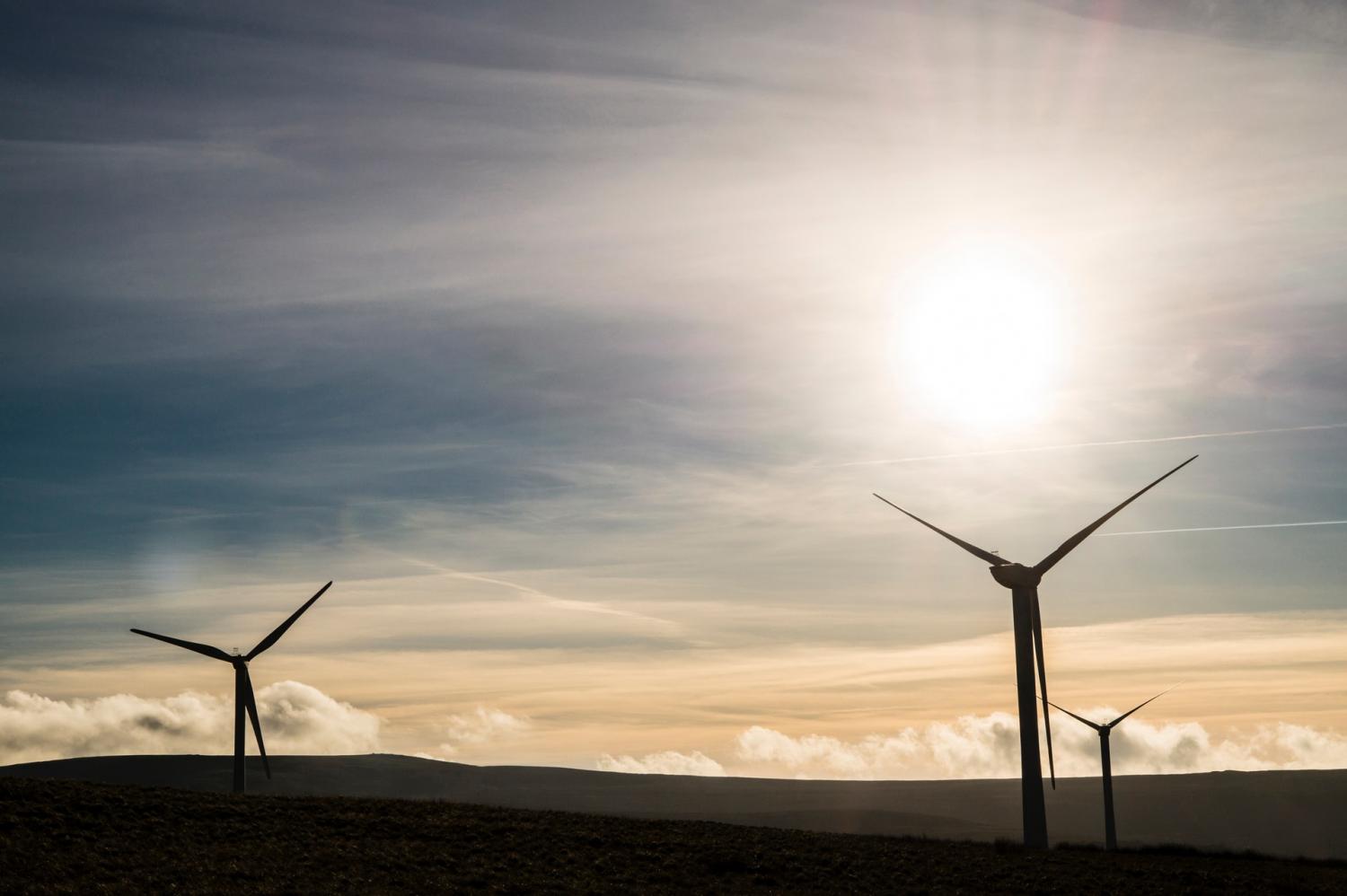

Businesses looking to raise their renewable energy profiles can look to the Estée Lauder Companies for inspiration. The umbrella for some of the top brands in personal care worldwide, Estée Lauder took its biggest single step into renewable energy in 2018, when it installed a 1-megawatt solar array at its Whitman Laboratories campus in the U.K. Now all of a sudden, the company has 22 MW of wind power in its sights for 2020.
Virtual renewable energy: as good as the real thing
Estée Lauder achieved the sharp increase in its renewable energy portfolio through what is called a virtual power purchase agreement (VPPA).
The idea is similar to a power purchase agreement. In a typical power purchase agreement, a ratepayer gets solar panels installed on their property without having to pay anything up front. They commit to purchasing the electricity (or an equivalent amount) generated by the solar panels, and they pay off the installation on a gradual basis through their monthly electricity bill. With the cost of solar power falling, the arrangement can save money overall for the property owner.
In addition, net metering programs in some states enable property owners to sell their unused electricity back to the local utility, creating even more opportunities for a bottom line benefit.
That’s all well and good, but there is a major limitation. Many electricity customers do not own properties that could accommodate solar arrays or, for that matter, wind turbines.
That’s where virtual power purchase agreements come in. VPPAs enable electricity users to claim clean power from renewable energy facilities located outside — sometimes far outside — of their own property.
In other words, the sky is the limit for companies seeking renewable energy.
Renewable energy for me…and thee
If this is starting to ring some bells, it should.
Last February, Bloomberg, Cox, Gap, Salesforce and Workday leveraged the VPPA model to claim 42.5 megawatts from a proposed 100-megawatt solar farm in North Carolina.
The deal caught attention partly because it upped the renewable energy profile of five companies with high name recognition. An even more significant element, though, was its potential for accelerating renewable energy development through the VPPA model.
With the five “anchor tenants” in hand, the solar developer was in a better position to forge ahead with the project, even though its capacity is not fully booked up. Once the new solar farm is completed, other ratepayers — including other businesses — will be able to benefit from access to clean power.
An ill wind in Oklahoma
A similar dynamic is at work in the Estée Lauder wind power deal.
The wind farm in question is the Ponderosa Wind Farm proposed by the company NextEra for Beaver County in Oklahoma.
Under the proposal, Ponderosa would consist of 80 wind turbines with a total capacity of 200 megawatts. Estée Lauder would get dibs on 22 megawatts of the total — if all goes according to plan, that is.
The problem is that the wind industry, in Oklahoma and elsewhere, has to address political opposition in addition to push back from property owners and other stakeholders.
Those stakeholders include the U.S. military, which is concerned about encroachment by wind farms on training grounds and other operations.
NextEra has already gotten burned by a new Oklahoma state law that requires additional documentation for wind farms that might run afoul of military operations. Earlier this year the company ditched plans for two wind farms totaling 320 megawatts in an area of Oklahoma affected by the new law.
Fortunately for Estée Lauder, the Ponderosa project passed muster with the Military Aviation and Assurance Siting Clearinghouse last July.
More renewable energy for the beauty industry
An unexpected monkey wrench from state policy makers is always a possibility in the months ahead. However, the support of a high profile, prestigious company with a brand like Estée Lauder at hand makes the going all the harder for critics.
In announcing the new wind farm deal, like Estée Lauder noted that it has other renewable energy contracts under its belt, but they are far surpassed by the Ponderosa project.
“The Ponderosa wind farm alone will cover more than half of the company’s global electricity footprint with renewable energy technologies, putting the company on target to meet its global 2020 Net Zero carbon emissions RE100 commitment,” the company stated.
Estée Lauder also took the opportunity to renew its commitment to science based targets for reducing greenhouse gas emissions. The science-based approach is a relatively new program that enables companies to set goals that align with the 2015 Paris Agreement on climate change and the recommendations of climate scientists.
As of this writing the Ponderosa wind project is on track to start construction in 2020.
When it does, Estée Lauder and its brands — including Clinique, Aveda, and Michael Kors, its namesake brand, among others — will reap the benefits.
Image credit: Ben Jessop/Pexels
How Solar Power Heats Up Competition for Hiring Veterans


Employers are focusing more attention hiring military veterans, and that’s a good thing. That presents new challenges for employers, though. As competition for talent from the hiring pool of veterans increases, employers have to offer more and better career opportunities. The U.S. solar industry provides a good example of the potential to ramp up much needed hiring programs.
Workforce pressure grows on the U.S. solar industry
With demand for solar power on the increase, the U.S. solar industry is under pressure to grow its workforce, veterans or not.
The Solar Foundation has tracked a 159 percent increase in solar jobs since 2010, the first year it began collecting statistics.
Though there has been a slight decline since employment in this sector peaked in 2016, as of 2018 there were over 242,000 solar workers in the U.S., defined as those who spend at least half of their time in solar-related work.
The decline is expected to be a temporary side effect of the Trump administration’s trade wars. Analysts are already anticipating a 7 percent uptick for solar jobs in 2019.
Building up the solar workforce is not only a necessity for solar companies, it is also an energy security issue for federal policy makers.
The Department of Energy began pumping millions into solar workforce training initiatives during the Obama administration. Those efforts have continued, even though the Trump administration does not generally support the expansion of renewable energy.
More and better solar jobs for veterans
One key holdover from the Obama administration is a program called Solar Ready Vets, which launched as a Department of Energy pilot program in 2014. That initiative involves connecting active duty military with solar training courses while they are still in service.
As the Energy Department’s primary solar workforce partner, The Solar Foundation administered the pilot program and grew it into a national solar jobs program beginning in 2017.
Last week, the program stepped up again with the introduction of two new solar employment tracks.
Solar Ready Vets still includes a focus on providing veterans with training, certification and professional development in aspects of the solar industry that mainly involve hands-on work.
That track is now called SOAR for “Solar Opportunities and Readiness.”
The solar industry is also among those recognizing that military skills and experience can transfer into career development and corporate leadership. To that end, Solar Ready Vets now includes a corporate management track, called the Solar Ready Vets Fellowship Program.
In partnership with the Hiring Our Heroes initiative of the U.S. Chamber of Commerce, the solar fellowship program involves a focus on skills that can potentially travel up the corporate ladder and across industries. In addition to installation, the fields of concentration include technical sales, system design, supply chain logistics, project development and operations.
An industrywide impact
As the Solar Foundation points out, integrating more veterans into the solar workforce goes beyond providing benefits at the granular level, to veterans and their employers.
Diversifying the workforce benefits the entire industry as well.
“Veterans are leaders and can help inspire confidence in the industry and navigate our most pressing challenges,” explained Abigail Ross Hopper, President and CEO of the Solar Energy Industries Association, in a public statement last week.
In this regard, the partnership with the U.S. Chamber of Commerce is notable. The organization has long been criticized for its skeptical stance on climate change and its opposition to renewable energy initiatives.
Earlier this year the Chamber of Commerce indicated a shift in attitude that dovetails with the promotion of solar jobs for veterans.
Eric Eversole, vice president at the U.S. Chamber of Commerce and president of the Hiring Our Heroes program, also drew a connection between military experience and industrywide reputation.
“The Corporate Fellowship Program will allow service members to learn more about career opportunities in solar and showcase their skills in an applied work environment while employers learn first-hand how much value military connected talent brings to their organizations,” he said.
The lessons are clear: to compete for the best and the brightest, companies need to approach veterans hiring on a holistic basis that encompasses a wide range of skills and embraces the potential for impacts across an entire industry.
Note: The Solar Foundation is currently pursuing private sector partners for its veterans programs. For more details visit SolarReadyVeterans.org.
Image credit: U.S. Department of Energy Office of Energy Efficiency and Renewable Energy/Facebook
Education Isn’t Always Top of Mind After Natural Disasters, But It Should Be
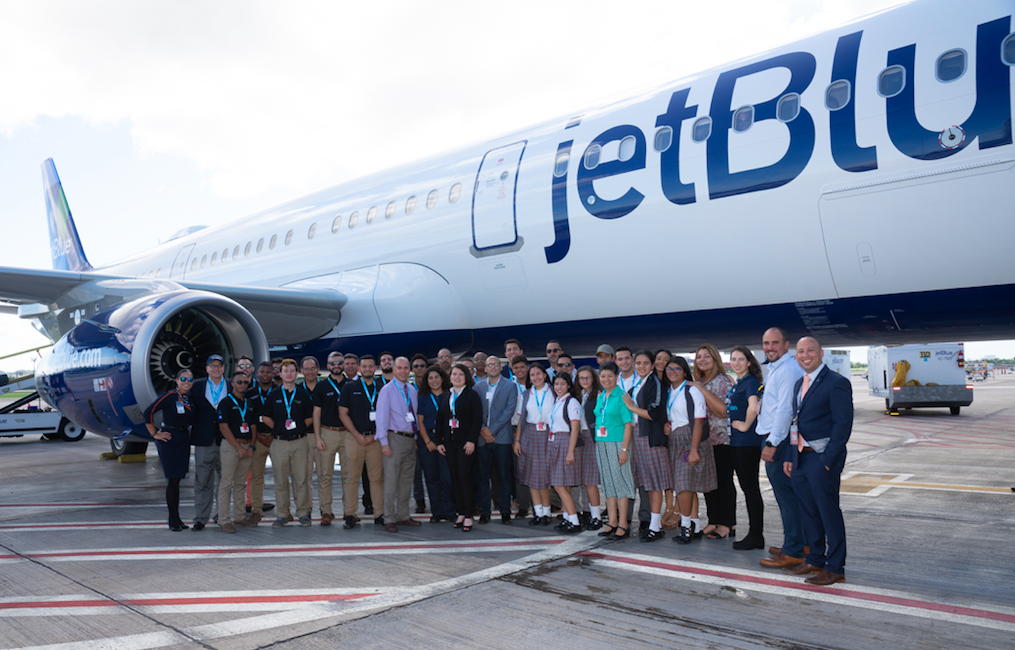

When natural disasters strike, people and corporations are generous, donating millions of dollars worth of food, medicines and other needed supplies. But often, in the urgency to address immediate life-threatening realities, the long-term needs of rebuilding communities are overlooked.
In fact, according to Jim Alvey, senior director of disaster recovery at the nonprofit Good360, 70 percent of donations occur within the first two months after a disaster, with only 5 percent allocated to critical long-term rebuilding and recovery.
Often it is children who are especially affected over the long-term, with researchers interviewed by the Washington Post reporting that academic performance and graduation rates generally drop after a disaster, as routines change and schools are forced to shutter due to damages.
Hurricane Maria makes the long-term impact of disaster all too clear
Findings like these quickly became reality when Hurricane Maria hit Puerto Rico in September 2017, killing an estimated 2,975 people. It was a hit close to home for the New York-based airline JetBlue, which has more flights to the island’s three main airports than any other carrier.
JetBlue and the JetBlue Foundation have invested in science, technology, engineering and math (STEM) education programs on the island for many years, as part of their focus on building a more diverse pipeline for the aviation industry. But instead of pulling out after Maria, the company dug in, helping with short-term relief and long-term recovery projects and investing an additional $100,000 in STEM projects on the island only a few months after the hurricane.
While JetBlue stepped up like many companies as soon as Maria hit with donated supplies and chartered flights, Ursula Hurley, president of the JetBlue Foundation, knew that wasn’t enough. For Hurley, the decision to up its investment in STEM education was all about focusing on the future.
“Our STEM programs are focused on building a pipeline of diverse pilots and aviation professionals over the long term,” she told TriplePundit. “After disasters, support for education doesn’t always come front-of-mind, but we think it’s extremely important.”
When disaster strikes, life grinds to a halt
One grantee that benefited from the additional funding was Girls in Aviation Puerto Rico (PR), which was already one year into a previous multi-year partnership with the JetBlue Foundation when Maria struck.
The program, hosted by the Inter American University of Puerto Rico, works to increase access and awareness of the aviation industry among girls in fifth through 12th grades.
Like other STEM and aviation programs that the JetBlue Foundation supports, Girls in Aviation seeks to reverse the dismal statistics of women in the industry, statistics that both Hurley and Caroline Ocasio, associate professor at the School of Aeronautics at the Inter American University of Puerto Rico and leader of Girls in Aviation PR, can recite from memory: In the United States, less than 7 percent of commercial pilots are women, and women make up only 3 percent of all aircraft mechanics and service technicians.
“Programs such as this are so needed,” Ocasio told 3p. “We are trying to pique the interest of girls and empower them with knowledge.”
When Girls in Aviation PR started in 2016, more than 70 girls quickly enrolled in the free program, which offered monthly seminars at the School of Aeronautics at the San Juan Airport and mentoring from JetBlue pilots. But when Maria hit, everything changed.
“We went into survival mode, it was day-to-day,” Ocasio remembers. “In my house, just like many other neighborhoods in Puerto Rico, we had no food, no water, no gas for the first two weeks. If you went to the grocery store, the shelves were empty, there was no food to sell. It was a very difficult time.”
And adults weren’t the only ones affected. According to research conducted after Maria, nearly 50 percent of children’s family’s homes on the island were damaged, nearly a quarter of youth helped rescue people, and more than 30 percent experienced shortages of food and water.
Schools across the island were closed for months, leaving families isolated. At home, many were sheltered indoors to protect them from downed trees, precarious structures and snapped electric cables. Electricity outages splintered communication and access to cellphones.
Ocasio herself had no way to communicate with most of her students, and the university where the girls had met was significantly damaged and without electricity. Ocasio was forced to put the program on hold for the next five months. For the girls she did have access to, she would send them emails and activities to do from time to time just to keep engaged.
When January arrived and communications had been partially restored for some residents, parents started to contact Ocasio telling her that their daughters were “dying to get back to the program.” She remembers their first meeting after Maria.
“It was very emotional. These girls, just like everyone else in Puerto Rico, really needed an escape from their daily reality and dealing with all these issues. We were here to support them,” Ocasio told us. “And that meant a lot.”
Girls thrive in the aftermath of the storm
Nearly two years later, despite losing a number of girls and their families who emigrated to the U.S. mainland, Girls in Aviation PR is back up to its pre-Maria enrollment of 70 girls and is aiming to reach 100. Of the original group, seven girls have graduated from high school, with five enrolled in college pursuing careers as pilots and one pursuing a career in meteorology.
As Ocasio tells it, the program has not only inspired the girls, but it has given them resilience.
She remembers one June night in 2018, not even a year after the hurricane, when the JetBlue Foundation hosted an event to celebrate the girls, attended by women pilots and other professionals from JetBlue . “It really showed the girls that we had [the company’s] support, they were there to work together with us, and we would continue despite what we all had been through. They knew then that they were just a phone call away.”
This article series is sponsored by JetBlue and produced by the TriplePundit editorial team.
Image credit: JetBlue
New Offshore Wind Partnership Signals North Carolina’s Renewables Leadership
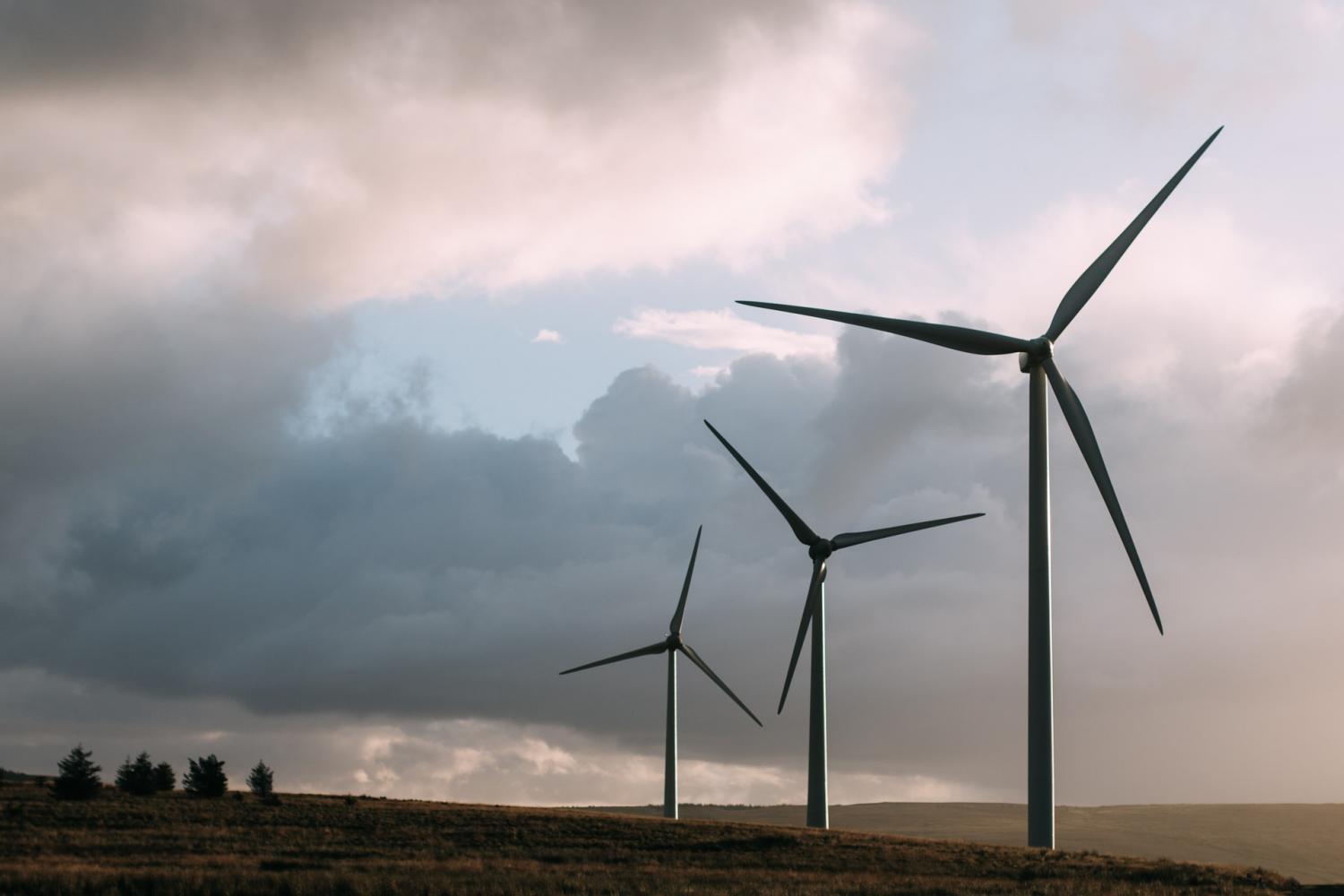

North Carolina Governor Roy Cooper has put an emphasis on transitioning the state to clean energy since his election in 2016, and the renewable energy industry is responding with alacrity.
In one of many efforts to kick the offshore wind deployment in North Carolina to the next level, the Business Network for Offshore Wind has added RenewComm as public relations counsel onboard. This announcement is just the latest in a string of efforts across the country to transform the energy economy. As a first act, the Business Network held a spotlight event focusing on North Carolina.
Such moves are important as North Carolina has been hit by three major hurricanes and suffered three so-called 500-year floods since 2018. Further, these extreme flood events have been punctuated by heatwaves and droughts. All of these events put strain on the electric grid. The state’s grid is powered by 90 percent fossil fuel- and nuclear-powered electricity.
In addition, coal, nuclear, and natural gas, respectively, are the most highly water-intensive energy sources. A centralized grid also creates challenges for resilience when the next big hurricane comes through – as during Hurricane Michael in 2018, when more than a million people were left without power.
It’s clear: North Carolina on the front line of climate change.
Enter Roy Cooper and his plans to transition to a cleaner energy economy. The state plans to double its solar capacity in the next five years, and Governor Cooper has announced plans to reduce greenhouse gas emissions by 40 percent by 2020 compared to 2005 levels. One-third of the state’s energy comes from nuclear helps with emissions, but there is a potential problem when the next heatwave or drought means that water will too hot, or levels too, low to safely cool these nuclear power plants.
Cooper does face some obstacles in the state with a legislature that is generally not supportive of climate change-friendly policies and what critics say is a monopoly held by Duke Energy. While Duke has set an ambitious net-zero carbon emissions goal, it is simultaneously making major renewable energy investments harder by putting its resources toward additional pipelines, fracking, and additional transmission to support centralized power plants. The state’s residents are already struggling with rate increases to fund these efforts as well as dealing with the effects of energy-related pollution, like toxic coal ash.
Efforts by the governor’s office to make the state more open for renewable energy investments are garnering a response from the industry, as evidenced by the recent announcement. As states grapple with the impacts of climate change, energy systems will need to be at the forefront of planning in order to ensure that they can operate or rebound in extreme weather.
For example, distributed solar panels can be helpful in extreme weather, as these panels are designed to withstand winds up to 140 miles per hour and benefit from being able to provide power while the grid is offline. Customers are starting to notice: In Texas, after Hurricane Harvey hit, there was a nearly 700 percent traffic spike in traffic in Texas to an article about whether solar panels could withstand hurricanes. Similarly, wind turbines are typically built to withstand winds up to 55 miles per hour. Although Harvey had winds nearly double that speed, some equipment was able to continue to generate power and function reliably. Nevertheless, sometimes the turbines couldn’t provide power because the local electric grid went down and there was nothing left to which these installations could connect.
Like the Bahamas after Hurricane Dorian and Puerto Rico after Hurricane Maria, leaders will need to consider how to deploy energy systems for a changing climate, to protect their citizens and systems. This latest announcement out of North Carolina is a step in that direction.
Image credit: Pixabay
How Interface is Transforming Manufacturing with its Net Zero Emissions Strategy
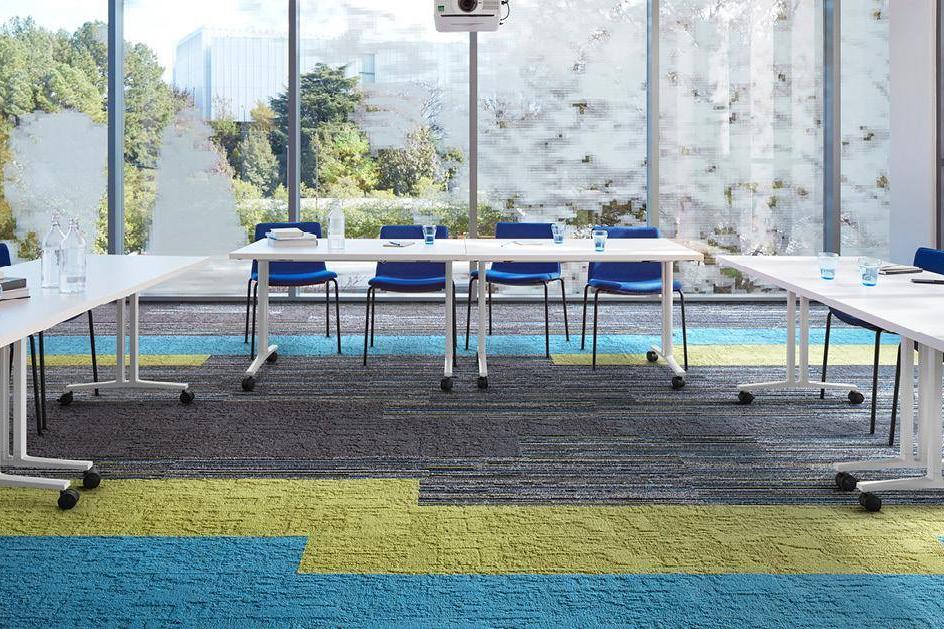

Twenty-five years ago, a customer asked Ray Anderson, "What's your company doing for the environment?"
Later describing this moment as a “spear in the chest,” the late founder of Interface Inc. credited his lack of an instantaneous response to this question as the moment that changed his perspective on business and its relationship with sustainability.
Today, Interface is a billion-dollar flooring company specializing in carbon neutral carpet tiles. Anderson’s drive to change his business practices in the early 1990s marked him as a corporate social responsibility (CSR) trailblazer. He proved that investing in more sustainable operations and producing more environmentally friendly products can lead to profitability as well as a competitive advantage.
Carpet manufacturing is a predominantly petroleum-intensive industry. And at times, the industry has come under fire over sustainability and health-related concerns. Issues include the release of volatile organic compounds (VOCs) during carpet installation and use of toxins like perfluorinated chemicals (PFCs or PFAS), applied to fibers as a stain repellent.
These concerns notwithstanding, the reality is that carpet is the most popular type of flooring sold in the United States. Carpet holds a 60 percent share of the market in the U.S., with 11 billion square feet sold per year. At the same time, 4 billion pounds of carpet enter the U.S.’s solid waste stream every year, with only 5 percent being recycled.
What is Interface doing to lessen its impact on the environment? The company has been changing industry practices by showing a better way forward.
In 1994, Anderson became motivated to eliminate Interface’s negative impact on the environment. What developed was the moonshot Mission Zero commitment, with the end goal of creating zero impact on the environment by 2020.
A year ahead of schedule, Interface just announced it achieved net-zero emissions.
One significant outcome of the initiative was the development of recycled nylon yarn. Instead of sourcing petroleum to produce nylon, Interface collaborated with its nylon supplier to develop a yarn made with recycled fibers. When the supplier began to sell this yarn to others, the outcome was a ripple effect across the entire industry. As a result, a more sustainable product established a foothold within the marketplace.
Another first achieved through Mission Zero happened when Interface partnered with the U.S. Environmental Protection Agency (EPA) and city of LaGrange, Georgia. Through the partnership, naturally occurring methane gas from a local landfill was converted into a sustainable energy source that replaced natural gas at Interface’s manufacturing plant. By turning waste into fuel to power the Interface manufacturing process, the company achieved 99 percent renewable energy use in its U.S. and European manufacturing sites. Other companies have since learned from this success.
Another disruption occurred in January 2019 when Interface reached a major milestone: Every flooring product that it sells— from carpet tile and LVT to rubber sheets and tiles—is now carbon neutral across its full lifecycle.
Along the path to meeting Mission Zero sustainability goals, Interface has disrupted the status quo—not only in carpet manufacturing, but across all of manufacturing. Anderson championed the notion of businesses doing well by doing good; hence Interface’s reputation as a leader in setting sustainability and corporate responsibility benchmarks for other manufacturing companies.
Guided by Anderson’s passion, Interface’s transformation was achieved by rethinking its factories, products and suppliers. In an industry where price and quality are the leading factors for consumers, Anderson wanted to do better. He was determined to reverse the negative environmental impacts manufacturing flooring created. For Anderson, doing business was not only about price, profit margins or personal gain—it was about doing what he knew to be right.
Anderson, who died from cancer in 2011, did not get to see Mission Zero come to complete fruition. But the positive ripple effects he inspired have transformed global standard operating practices, and the parts of the world he touched will be left better than they were found.
In continuing the company’s mission to champion environmental stewardship, Interface’s next moonshot goal is Climate Take Back. This initiative launched in 2016 with an aim to make Interface a carbon negative company by 2040 and inspire a movement to reverse global warming. By focusing on four key areas, the company said its Climate Take Back strategy can be implemented to “create a climate fit for life.”
For businesses and organizations taking action to address the effects of climate change, it behooves them to explore what Interface is doing—best practices are designed to be shared.
Image credit: Interface/Facebook
Solar Power Is for Cold Climates, Too
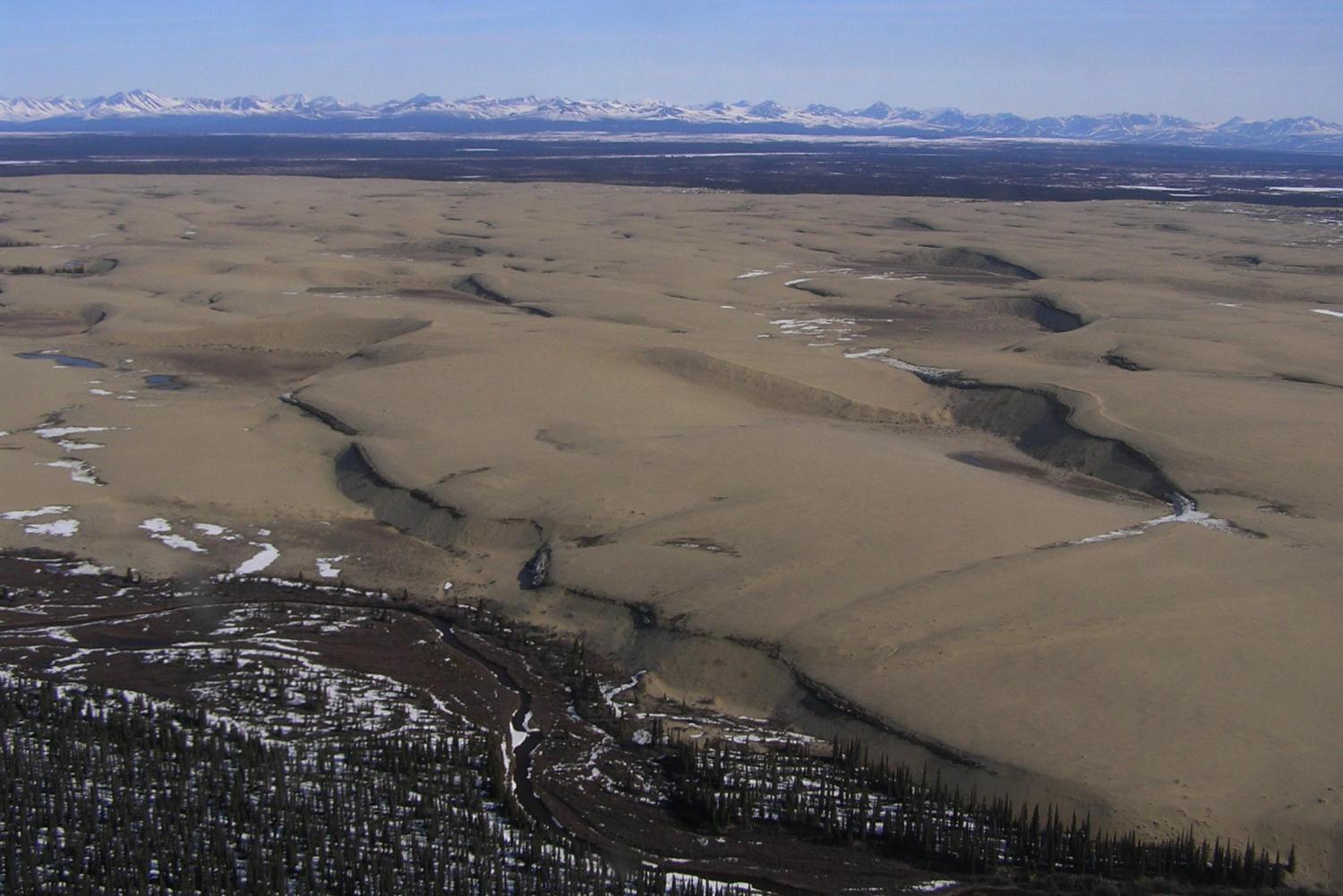
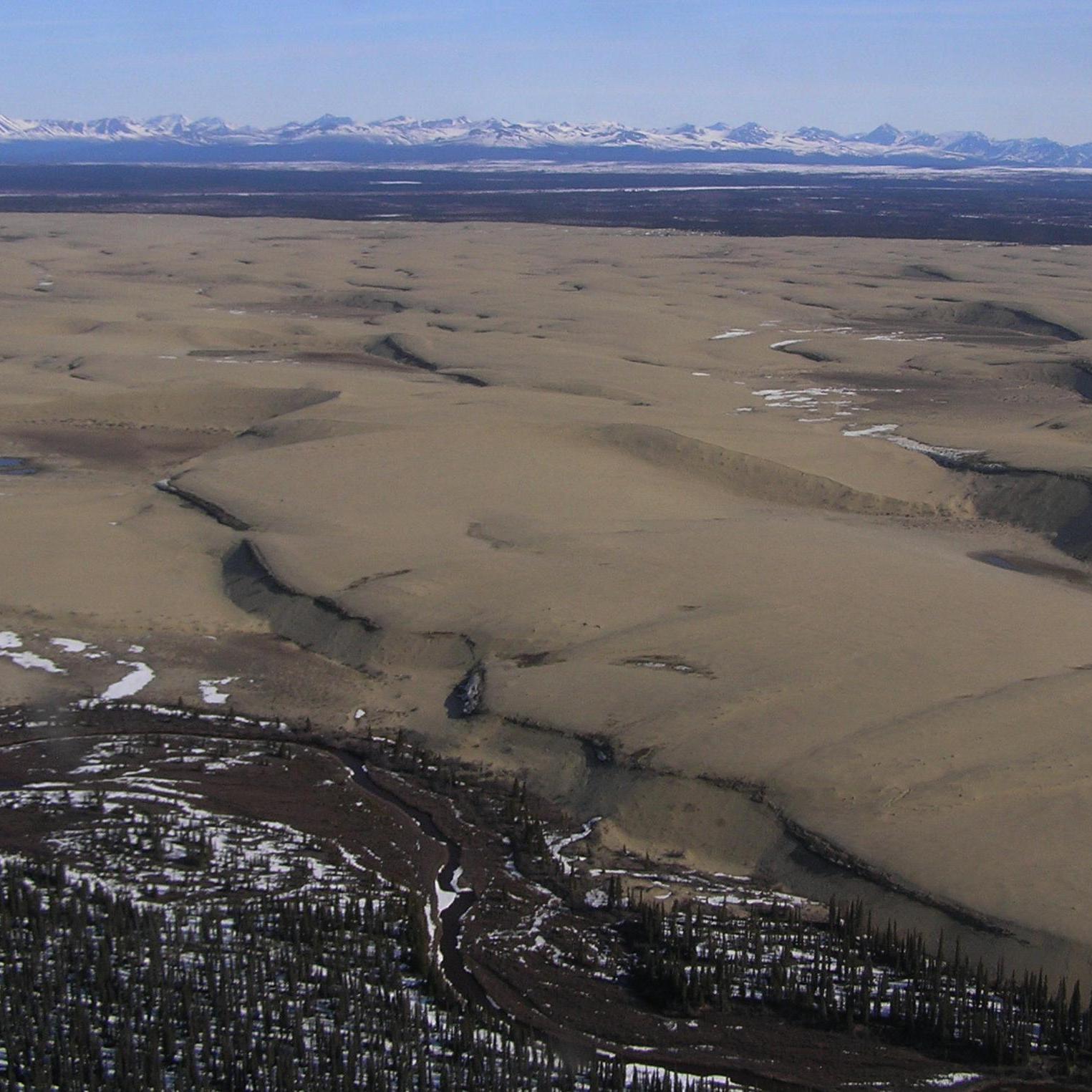
The warm, sunny southwestern U.S. is a hotspot for solar power, but businesses in chillier, gloomier regions can also benefit from the switch to renewable energy. That’s especially true for companies in remote areas, where fossil fuels are more expensive. With the cost of solar panels continuing to fall, a clean tech makeover can cut carbon emissions while saving money, too.
Solar power in Alaska?
Alaska has become the epicenter of important environmental battles over the use of fossil fuels, including wildlife conservation and climate change.
Until recently, though, it seemed that Alaska’s residents and businesses had little opportunity to participate in the renewable energy transition, considering its cold climate and far-flung villages.
Nevertheless, Alaska has become a test bed for the financial benefits of small scale, local solar power.
One such project is getting under way this month in the village of Ambler, population 287, located near Kobuk Valley National Park (shown above).
Ambler is located 45 miles north of the Arctic Circle, in the Northwest Arctic Borough. Access is primarily by barge, plane, small boat and snowmachine.
At first glance, the region may not seem ideal for solar power. Though total precipitation is relatively low at 9 inches per year, that includes an average of 47 inches of snow.
Still, about 70 homes in Ambler are being fitted out with their own solar arrays this year.
Yes, solar power in Alaska!
With a capacity of 1 kilowatt each, the new household solar arrays are miniscule. However, they will have an outsized impact on energy consumption in the village.
The solar arrays are just part of a broader energy efficiency initiative for Ambler. Each home is also getting new LED lights and a heat pump.
With the help of solar power during the day, the heat pumps can work without drawing electricity from the local grid.
The heat pumps will be operated only part of the year, when the temperature is above zero degrees Fahrenheit. However, that is enough to realize significant savings.
The combination of heat pumps, LEDs, and solar arrays cost each home about $8,200. The annual fuel saving per home is expected to range from $2,000 to $3,000, meaning that the systems will pay for themselves in just a few years.
Cleaner and safer
Aside from the financial benefits, the Ambler solar power project also involves public health improvements.
Alaska Public Media recently took a look at a home in Ambler that has pilot-tested the system over the past two years and noted that the heat pumps can be used to filter indoor air. That’s an important improvement for homes that rely on wood stoves for heating.
The heat pumps can also provide filtration for outdoor air, a significant benefit for communities like Ambler with dusty, unpaved roads.
Overall comfort is another consideration. By reducing the financial pressure on household energy bills, the solar panels enable residents to keep indoor temperatures at a more healthful level.
As for the impact of Ambler’s cold, snowy climate on solar panel output, researchers are beginning to accumulate evidence that solar panels can function more efficiently in cold weather. Snow can help by reflecting additional light onto the solar panels, too.
Big plans for small scale solar
On the other end of the scale, the largest solar array in Alaska began construction earlier this year at the village of Hughes, 210 miles from Fairbanks by air.
The U.S. Department of Energy is supporting the project, which consists of a 120-kilowatt solar array this year and an equal amount of energy storage. The system will integrate with the local grid to help cut overall power costs.
Hughes (population 110), currently uses more than 40,000 gallons of diesel annually to generate electricity for the community, all of which is transported on aging planes that date back to the 1950’s — which involves using even more fossil fuel.
With those costs involved, it’s little wonder that the residents of Hughes pay more than 70 cents per kilowatt hour for electricity.
By producing some of its electricity through local solar energy, the village will cut its costs while reducing carbon emissions from diesel fuel. It will also reduce emissions related to fuel transportation as well.
Although the system is tiny compared to the utility-scale arrays elsewhere in the U.S., it will save about $54,000 annually over its 20-year lifespan. That will go a long way in Hughes.
As the Hughes and Ambler projects demonstrate, location does not have to be an obstacle for businesses seeking solar power and other sources of clean technologies. Even if renewable energy is available only part-time, it can still make a big difference in overall energy costs and carbon emissions.
A corollary to that is the opportunity for businesses to enter new markets in remote locations — or any location, for that matter — by taking advantage of the falling cost of renewable energy.
Image credit: LCGS Russ/Wiki Commons
How Digital Technologies Can Enable Other Sectors to Accelerate Climate Action


An International Energy Outlook report from the U.S. Energy Information Administration projects that world energy consumption will grow by 28 percent between 2015 and 2040, and greenhouse gas (GHG) emissions will grow accordingly because fossil fuels still account for more than three-quarters of world energy consumption through 2040. Similarly, in the mobile wireless world, each successive generation (3G, 4G etc.) has brought an increase in energy consumption even as it enables more services and reaches more people.
The exponential climate action roadmap published in late September tells us that global GHG emissions need to peak by 2020 at the latest and reduce by 50 percent before 2030. Yet the world is not on track to meet these goals. The good news? The information and communication technologies (ICT) sector is doing its part. The sector is already on its way to reducing carbon emissions.
Digital technology companies only accounts for a small percentage of greenhouse gas emissions. According to the roadmap, the ICT industry’s own footprint has stayed flat for several years at 1.4 percent of overall global emissions in spite of exponential data growth during that same time.
Now, it’s time to focus on the impact the ICT sector can have on other industries. The footprint of digital industries is comparatively small, but the handprint could be huge. Of the 36 solutions identified in the roadmap required to slash greenhouse gas emissions 50% by 2030, one-third can be enabled by ICT technology, meaning the impact ICT can have on other industries can be far reaching.
As the leading creator of carbon emissions, the energy industry, which currently accounts for two thirds of global greenhouse gas emissions, would be greatly impacted by ICT technology. In addition to being one of the largest purchasers of renewable energy to power networks and data centers. The ICT industry is also focused on increasing network performance through energy efficient hardware modernization and software solutions.
5G, the latest generation of mobile wireless, will accelerate the development of the Internet of Things (IoT), which in turn will allow us to better monitor energy consumption through an estimated 4.1 billion cellular IoT connections globally by 2024. When combined with AI and machine learning, this will kick off a fourth industrial revolution, where billions of connections and sensors will provide us with real-time data and remote operating capabilities necessary to make big leaps in energy efficiency and exponential climate action.
But they are not alone, ICT can benefit other sectors, such as benefiting the transportation by empowering smart transportation, optimizing routes and traffic or monitoring performance of vehicles for energy efficiency. It can benefit agriculture by automating practices and utilizing IoT to optimize agricultural practices, such as watering plants and milling soil. ICT can benefit companies across the country simply by empowering smart buildings that monitor and limit energy usage.
The possibilities are far-reaching, and but they must be accelerated, in part by the widespread adoption of 5G, to reach the necessary scale by 2030. A few early success stories:
- Einride's T-pod: Einride is creating a sustainable transportation ecosystem with 5G providing the connectivity and reliability to safely introduce T-pods onto public roads, paving the way for 90% reduction in carbon emissions and elimination of nitrogen oxide (NOx) emissions.
- Boliden Mining Automation: Fully automated/remotely controlled trucks (connected by 5G) drive more efficiently, this smoother transport flow, steadier speed and less movement means lower fuel consumption eliminating an estimated 9,400 metric tons of CO2 emissions at Boliden’s Aitik mine.
- Bladed Disks (BLISKs) Manufacturing: BLISKs are critical components of turbines like aircraft jet engines. Automated production with real time monitoring and control enabled by 5G can reduce manufacturing time, and just a 2% increase in efficiency can eliminate 16 million metric tons of carbon emissions annually.
Digital technologies can help reduce overall global greenhouse gas emissions by up to 15 percent through solutions in energy, manufacturing, agriculture and land use, buildings, services and transportation. If done right, this could account for a third of the GHG emission reduction required by 2030. Enabled by 5G and the IoT, our sector can help support a sustainable future for everyone.
Image credit: Unsplash